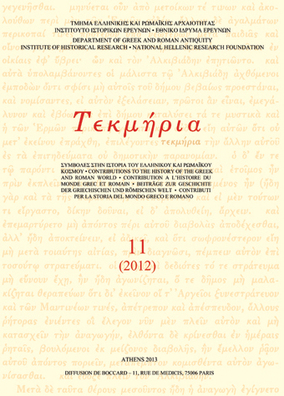Ἱστορικὲς καὶ ἀρχαιογεωμορφολογικὲς ἔρευνες γιὰ τὴν διώρυγα τοῦ Ξέρξου στὴν χερσόνησο τοῦ Ἄθω
Part of : Τεκμήρια ; Vol.4, 1998, pages 177-184
Issue:
Pages:
177-184
Parallel Title:
Historical and archaeogeomorphological researches in the Xerxes's canal at the Athos Peninsula
Section Title:
Σύμμεικτα
Abstract:
There are two questions about the so-called Xerxes's canal: a) Was the canal navigable all along the isthmus or just for a part of it? b) Was it a channel or a διολκός? Our research has so far led us to the following conclusions : 1. The name of the area is «Provlakas» or «Preavlakas», which means διολκός, is already mentionned since 1018. 2. The southern half of the «canal» from 982 till during the 14th century, is reported as «Diavripos stream», a name related to the technical term «evripos» (=canal). 3. The «canal» was located inside the enclosure of the fortification walls of the later built Ouranopolis (316 BC) and divided the fortified area into two parts. 4. At the northern part of the «canal» there is a swamp, which possibly reduced the width of the isthmus by 350 meters. 5. An «ancient building», already mentionned since 13th century, is located at the «canal» 's northern coastline. Possibly it formed part of the northern coastal fortification wall of Ouranopolis, or part of the pier. In the second case the port must have taken at least a part of the swamp. 6. After our research in 61 coastal archaeological sites all over Chabkidiki 's coastline, we concluded that there is no older coastline on a level higher than the present, and the rise of the relative sea level by approximately 2,5 meters occurred from the 5th century BC. Accordingly the isthmus was a little wider during the Classical period than it is today. 7. The -2.3 meters beachrocks located at the northern coastline, where we detected embodied pottery, indicate an ancient coastline, in front of the swamp which must be earlier than the 4th century BC. 8. There is a question about the depth of conjunction, under the «canal», of the granite and gneiss that outcrop right and left of it. We propose the completion of the research by carrying out the following tasks: 1. A sampling core at the southern river's blocked estuary, which should reach a depth of 6 meters. In case that gneiss or other rocks of terrestrial origin appear in a depth of less than 4,5 meters, the navigability of the «canal» at that critical part must be excluded. 2. A secont sampling core at the crossing of the granite 's appearance and the «canal» 's axis. The coring depth must be equal to the one of 6 meters mentioned previously, plus the elevation difference between the coring point and the present sea level. In case of negative findings, the possibility of excavation of a navigable «canal» must be excluded and the research must focus at the investigation for the remains of διολκός. 3. In order to detect the existence of an ancient port at the area of the northern swamp, we must get at least one sampling core till the depth of 6 meters + the elevation difference at a predetermined point of the swamp. The existence or not of marine environment at the appropriate depth will be ascertained. If the results are positive they should be followed by an excavatory research.
Subject:
Subject (LC):




